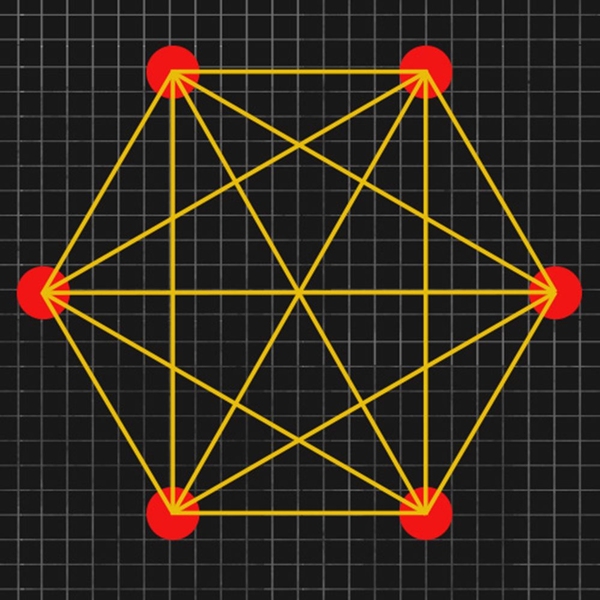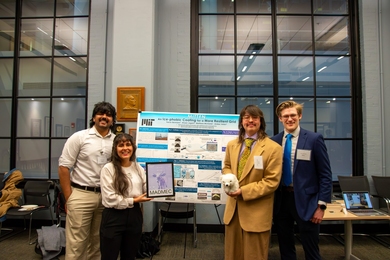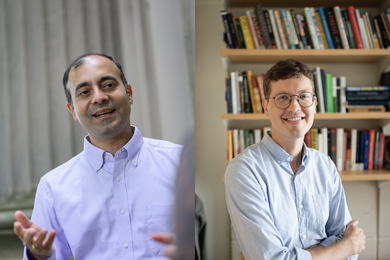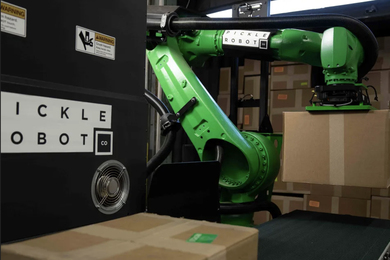Quantum computers are devices — still largely theoretical — that could perform certain types of computations much faster than classical computers; one way they might do that is by exploiting “spin,” a property of tiny particles of matter. A “spin chain,” in turn, is a standard model that physicists use to describe systems of quantum particles, including some that could be the basis for quantum computers.
Many quantum algorithms require that particles’ spins be “entangled,” meaning that they’re all dependent on each other. The more entanglement a physical system offers, the greater its computational power. Until now, theoreticians have demonstrated the possibility of high entanglement only in a very complex spin chain, which would be difficult to realize experimentally. In simpler systems, the degree of entanglement appeared to be capped: Beyond a certain point, adding more particles to the chain didn’t seem to increase the entanglement.
This month, however, in the journal Physical Review Letters, a group of researchers at MIT, IBM, Masaryk University in the Czech Republic, the Slovak Academy of Sciences and Northeastern University proved that even in simple spin chains, the degree of entanglement scales with the length of the chain. The research thus offers strong evidence that relatively simple quantum systems could offer considerable computational resources.
In quantum physics, the term “spin” describes the way that tiny particles of matter align in a magnetic field: A particle with spin up aligns in one direction, a particle with spin down in the opposite direction. But subjecting a particle to multiple fields at once can cause it to align in other directions, somewhere between up and down. In a complex enough system, a particle might have dozens of possible spin states.
A spin chain is just what it sounds like: a bunch of particles in a row, analyzed according to their spin. A spin chain whose particles have only two spin states exhibits no entanglement. But in the new paper, MIT professor of mathematics Peter Shor, his former student Ramis Movassagh, who is now an instructor at Northeastern, and their colleagues showed that unbounded entanglement is possible in chains of particles with only three spin states — up, down and none. Systems of such particles should, in principle, be much easier to build than those whose particles have more spin states.
Tangled up
The phenomenon of entanglement is related to the central mystery of quantum physics: the ability of a single particle to be in multiple mutually exclusive states at once. Electrons, photons and other fundamental particles can, in some sense, be in more than one place at the same time. Similarly, they can have more than one spin at once. If you try to measure the location, spin or some other quantum property of a particle, however, you’ll get a definite answer: The particle will snap into just one of its possible states.
If two particles are entangled, then performing a measurement on one tells you something about the other. For instance, if you measure the spin of an electron orbiting a helium atom, and its spin is up, the spin of the other electron in the same orbit must be down, and vice versa. For a chain of particles to be useful for quantum computing, all of their spins need to be entangled. If, at some point, adding more particles to the chain ceases to increase entanglement, then it also ceases to increase computational capacity.
To show that entanglement increases without bound in chains of three-spin particles, the researchers proved that any such chain with a net energy of zero could be converted into any other through a small number of energy-preserving substitutions. The proof is kind of like one of those puzzles where you have to convert one word into another of the same length, changing only one letter at a time.
“Energy preserving” just means that changing the spins of two adjacent particles doesn’t change their total energy. For instance, if two adjacent particles have spin up and spin down, they have the same energy as two adjacent particles with no spin. Similarly, swapping the spins of two adjacent particles leaves their energy the same. Here, the “puzzle” is to convert one spin chain into another using only these and a couple of other substitutions.
No bottlenecks
If you envision every set of definite spins for a chain of three-spin particles as a point in space, and draw lines only between those that that are interchangeable using energy-preserving substitutions, then you end up with a well-connected network.
“If you want to go from any state to another state, it has high conductivity,” Movassagh says. “It’s like, if you have a town with a bunch of alleys, and you want to go from any neighborhood to any other, you can only go rapidly if there’s no one road that’s necessary to use and congested.” To prove that, in systems of three-spin particles, transitions between sets of spin were possible through these “back alleys,” Movassagh says, “we proved something that we think is new in probability theory.”
“It’s been known that if the particles can have constant but rather high dimension” — that is, number of possible spin states — “the entanglement can be pretty high,” says Sandy Irani, a professor of computer science at the University of California at Irvine who specializes in quantum computation. “But the requirement is that these little particles have something like dimension 14, 15, 16. In terms of what people are actually looking at experimentally, they’re looking at very low-dimensional things. Having particles of dimension of 15, 16, is much more difficult to bring about in the lab.”
Shor, Movassagh and their colleagues, Irani says, “have shown that if you just step up from two to three, the entanglement can actually grow with the number of particles.”
Irani cautions, however, that the new paper shows only that entanglement scales logarithmically with the length of the spin chain. “If you go up to these larger-dimension particles, in the teens, you get entanglement that can scale with the number of particles instead of the log of the number of particles,” she says, “and that may be required for quantum computing.”
Many quantum algorithms require that particles’ spins be “entangled,” meaning that they’re all dependent on each other. The more entanglement a physical system offers, the greater its computational power. Until now, theoreticians have demonstrated the possibility of high entanglement only in a very complex spin chain, which would be difficult to realize experimentally. In simpler systems, the degree of entanglement appeared to be capped: Beyond a certain point, adding more particles to the chain didn’t seem to increase the entanglement.
This month, however, in the journal Physical Review Letters, a group of researchers at MIT, IBM, Masaryk University in the Czech Republic, the Slovak Academy of Sciences and Northeastern University proved that even in simple spin chains, the degree of entanglement scales with the length of the chain. The research thus offers strong evidence that relatively simple quantum systems could offer considerable computational resources.
In quantum physics, the term “spin” describes the way that tiny particles of matter align in a magnetic field: A particle with spin up aligns in one direction, a particle with spin down in the opposite direction. But subjecting a particle to multiple fields at once can cause it to align in other directions, somewhere between up and down. In a complex enough system, a particle might have dozens of possible spin states.
A spin chain is just what it sounds like: a bunch of particles in a row, analyzed according to their spin. A spin chain whose particles have only two spin states exhibits no entanglement. But in the new paper, MIT professor of mathematics Peter Shor, his former student Ramis Movassagh, who is now an instructor at Northeastern, and their colleagues showed that unbounded entanglement is possible in chains of particles with only three spin states — up, down and none. Systems of such particles should, in principle, be much easier to build than those whose particles have more spin states.
Tangled up
The phenomenon of entanglement is related to the central mystery of quantum physics: the ability of a single particle to be in multiple mutually exclusive states at once. Electrons, photons and other fundamental particles can, in some sense, be in more than one place at the same time. Similarly, they can have more than one spin at once. If you try to measure the location, spin or some other quantum property of a particle, however, you’ll get a definite answer: The particle will snap into just one of its possible states.
If two particles are entangled, then performing a measurement on one tells you something about the other. For instance, if you measure the spin of an electron orbiting a helium atom, and its spin is up, the spin of the other electron in the same orbit must be down, and vice versa. For a chain of particles to be useful for quantum computing, all of their spins need to be entangled. If, at some point, adding more particles to the chain ceases to increase entanglement, then it also ceases to increase computational capacity.
To show that entanglement increases without bound in chains of three-spin particles, the researchers proved that any such chain with a net energy of zero could be converted into any other through a small number of energy-preserving substitutions. The proof is kind of like one of those puzzles where you have to convert one word into another of the same length, changing only one letter at a time.
“Energy preserving” just means that changing the spins of two adjacent particles doesn’t change their total energy. For instance, if two adjacent particles have spin up and spin down, they have the same energy as two adjacent particles with no spin. Similarly, swapping the spins of two adjacent particles leaves their energy the same. Here, the “puzzle” is to convert one spin chain into another using only these and a couple of other substitutions.
No bottlenecks
If you envision every set of definite spins for a chain of three-spin particles as a point in space, and draw lines only between those that that are interchangeable using energy-preserving substitutions, then you end up with a well-connected network.
“If you want to go from any state to another state, it has high conductivity,” Movassagh says. “It’s like, if you have a town with a bunch of alleys, and you want to go from any neighborhood to any other, you can only go rapidly if there’s no one road that’s necessary to use and congested.” To prove that, in systems of three-spin particles, transitions between sets of spin were possible through these “back alleys,” Movassagh says, “we proved something that we think is new in probability theory.”
“It’s been known that if the particles can have constant but rather high dimension” — that is, number of possible spin states — “the entanglement can be pretty high,” says Sandy Irani, a professor of computer science at the University of California at Irvine who specializes in quantum computation. “But the requirement is that these little particles have something like dimension 14, 15, 16. In terms of what people are actually looking at experimentally, they’re looking at very low-dimensional things. Having particles of dimension of 15, 16, is much more difficult to bring about in the lab.”
Shor, Movassagh and their colleagues, Irani says, “have shown that if you just step up from two to three, the entanglement can actually grow with the number of particles.”
Irani cautions, however, that the new paper shows only that entanglement scales logarithmically with the length of the spin chain. “If you go up to these larger-dimension particles, in the teens, you get entanglement that can scale with the number of particles instead of the log of the number of particles,” she says, “and that may be required for quantum computing.”






